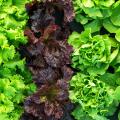Kale
Kale

This close relative of cabbage and collards is best grown in the fall garden. Light frost improves the flavor, and in some years, kale plants survive the winter to produce an early spring crop of leaves.
Sow seeds directly in the garden in late summer, and thin plants to stand 8 to 12 inches apart. Harvest the lower leaves, or cut the entire plant. Aphids and leaf-eating worms, such as cabbage loopers and imported cabbage moths, are the most serious pests.
Kale is available in two different types—a curly-leafed type that is normally used for eating and an ornamental type used for garnish. Be sure to grow the correct variety for eating.
Varieties
- Dwarf Siberian—hardy; vigorous; large, coarse leaves; deep bluish-green color.
- Vates—low, spreading; hardy; slow bolting; leaves curled.
- Winterbor—very curly leaves; cold tolerant.
Publications
News
Vegetable producers across the Southeast are invited to the 2025 Vegetable Field Day on July 23 at the Mississippi State University station in Verona, Mississippi.
If you grow your own vegetables, you will likely see at least a few pesky insects that want to feed on your plants. Slugs are one of the pests you may be noticing now.
Did you know yellow squash is in the pumpkin family and are 95 percent water?



